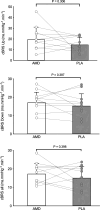Does a single oral administration of amiloride affect spontaneous arterial baroreflex sensitivity and blood pressure variability in healthy young adults?
- PMID: 39110514
- PMCID: PMC12121373
- DOI: 10.1152/jn.00264.2024
Does a single oral administration of amiloride affect spontaneous arterial baroreflex sensitivity and blood pressure variability in healthy young adults?
Abstract
Preclinical models indicate that amiloride (AMD) reduces baroreflex sensitivity and perturbs homeostatic blood pressure (BP) regulation. However, it remains unclear whether these findings translate to humans. This study investigated whether oral administration of AMD reduces spontaneous cardiac and sympathetic baroreflex sensitivity and perturbs BP regulation in healthy young humans. Heart rate (HR; electrocardiography), beat-to-beat BP (photoplethysmography), and muscle sympathetic activity (MSNA, microneurography) were continuously measured in 10 young subjects (4 females) during rest across two randomized experimental visits: 1) after 3 h of oral administration of placebo (PLA, 10 mg of methylcellulose within a gelatin capsule) and 2) after 3 h of oral administration of AMD (10 mg). Visits were separated for at least 48 h. We calculated the standard deviation and other indices of BP variability. Spontaneous cardiac baroreflex was assessed via the sequence technique and cardiac autonomic modulation through time- and frequency-domain HR variability. The sensitivity (gain) of the sympathetic baroreflex was determined via weighted linear regression analysis between MSNA and diastolic BP. AMD did not affect HR, BP, and MSNA compared with PLA. Indexes of cardiac autonomic modulation (time- and frequency-domain HR variability) and BP variability were also unchanged after AMD ingestion. Likewise, AMD did not modify the gain of both spontaneous cardiac and sympathetic arterial baroreflex. A single oral dose of AMD does not affect spontaneous arterial baroreflex sensitivity and BP variability in healthy young adults.NEW & NOTEWORTHY Preclinical models indicate that amiloride (AMD), a nonselective antagonist of the acid-sensing ion channels (ASICs), impairs baroreflex sensitivity and perturbs blood pressure regulation. We translated these findings into humans, investigating the impact of acute oral ingestion of AMD on blood pressure variability and spontaneous cardiac and sympathetic baroreflex sensitivity in healthy young humans. In contrast to preclinical evidence, AMD does not impair spontaneous arterial baroreflex sensitivity and blood pressure variability in healthy young adults.
Keywords: acid-sensing ion channels; blood pressure; muscle sympathetic nerve activity.
Conflict of interest statement
No conflicts of interest, financial or otherwise, are declared by the authors.
Figures




References
Publication types
MeSH terms
Substances
Grants and funding
LinkOut - more resources
Full Text Sources

